(459) Why is Kannon popular? [調べる]

・ Kannon is a Bodhisattva more familiar to us than Buddah Amida.・ Kannon can appear in many different forms to save people.・ Kannon can save us in this world, this is a benefit gained in this world.
Buddhism for the Common Folk.
The three deities Amida, Kannon, and Jizō, became especially popular among the common folk during the Kamakura Period (1185 - 1333 AD), and today remain the bedrock of Buddhism for the common folk.
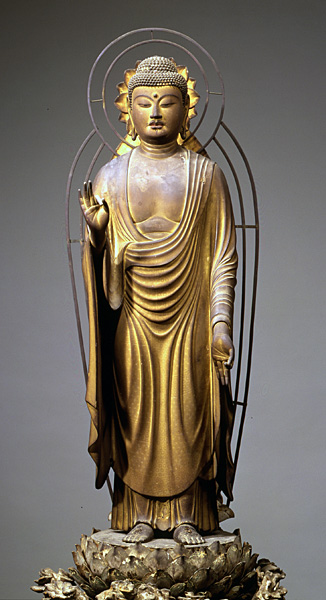
◆2. Kannon for salvation in earthly life. ◆

◆3. Jizō for salvation from hell.◆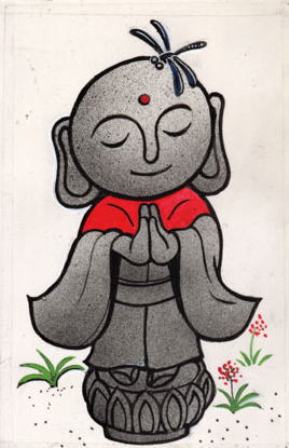
---A to Z Photo Dictionary Japanese Buddhist Statuary---
1. Buddah Amida 阿弥陀仏
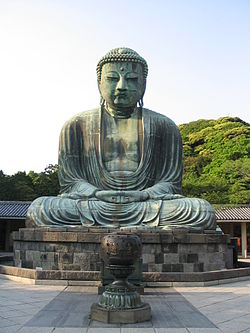
Amida of Kamakura
Buddha Daibutsu, Kamakura, Japan. This statue, made of bronze, is 11.40 m high and weights 93 t.
THE BUDDHA are those who have attained enlightenment, the ultimate state.
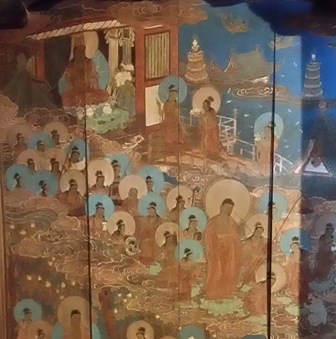
Taisanji temple, Matsuyama, Ehime
At the belltower of Taisanji-temple you can see 25 Bodhisattva who descend from heaven with Amida to welcome the dying soul
of the faithful into Amida’s Pure Land of Ultimate Bliss (Jp. = 極楽 Gokuraku; also called Jōdo 浄土)
2. Kannon
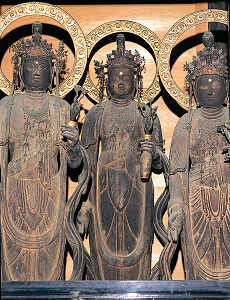
Taisan-ji temple, Matsuyama, Ehime
2.1. What is Kannon?
2.1.1. TRANSLATION.
“One who sees / hears all.”
The Sino-Japanese term Kannon 観音 (Chinese = Guānyīn) literally means watchful listening, and is
often translated as “one who sees / hears all.” This is indeed the task of the compassionate Kannon — to witness and listen to the prayers and cries of those in difficulty in the earthly realm, and to help them achieve salvation.
---A to Z Photo Dictionary Japanese Buddhist Statuary---
2.1.2. SCRIPTURAL BASIS.
Kannon is a Bodhisattva (Jp. = Bosatsu), one who achieves enlightenment but postpones Buddhahood until all can be saved. Kannon is mentioned in numerous Mahayana sutra (religious texts), especially the Lotus Sutra 法華経 (Hokekyō), which was translated into Chinese by Kumārajīva (Jp. = Kumarajū 鳩摩羅什, 350 - 410),
---A to Z Photo Dictionary Japanese Buddhist Statuary---
2.1.3. MEMBER OF PURE LAND SECTS
In Mahayana Buddhism throughout Asia, Kannon is the most important of Amida’s two main
attendants (kyōji 脇侍). The other is Seishi Bosatsu. In Japan, the three appear in a popular grouping known as the Amida Sanzon (lit. =Amida Triad), with Amida in the center, Seishi (representing wisdom) on the right, and Kannon (representing compassion) on the left.
2.1.4. KANNON PILGRIMAGES
Kannon can appear in many different forms to save people. The Lotus Sutra (Hokekyō 法華経), one of the most popular Mahayana scriptures throughout Asia owing to its message that anyone,
whether male or female, has the potential to attain Buddhahood, mentions 33 (thirty-three) forms that Kannon assumes when aiding sentient beings. In modern Japan, Kannon’s 33 forms are the basis for hundreds of Kannon Pilgrimage Circuits.
2.1.5. ESOTERIC KANNON FORMS.
In addition to the 33 Forms of Kannon, this deity also comes in six salvific forms to save all sentient beings trapped in the Six Realms of Karmic Rebirth (the cycle of suffering, the cycle of samsara).
2.2. A story behind Taisan-ji temple.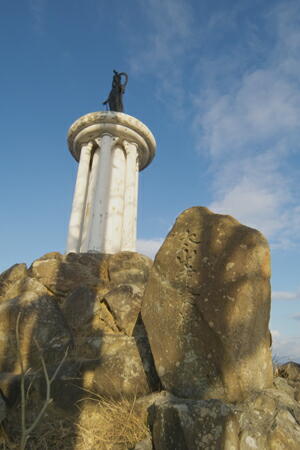
There is a story in Taisan-ji temple showing Kannon’s power to save the people who prayed to Kannon. This is a benefit gained in this world through observance of the Buddhist teachings, in Japanese 現世利益.
A certain merchant from Kyushu was sailing to the Osaka area to transport lumber his ship was caught in a terrible storm near Takahama on the other side of the mountain where Taisa-ji temple stands. He prayed to Kannon and soon a five-colored beam of the light appeared from the mountain top. By this light, he was able to land safely.

Mano-chouja, a merchant in Kyushu
2.3 Juichimen Kannon 十一面観音

Literally 11-Headed Kannon, or 11-Faced Kannon. One of the Six Kannon. This beloved esoteric (tantric) form of Kannon is depicted with eleven heads atop its crown. There are various explanations for the eleven heads.
2.3.1. Why 11-faced?
On a folk level,
1) some say it is symbolic of shedding sweetness and mercy in all directions,
2) others that Kannon became so distressed after witnessing the sufferings of the world that .
But the most plausible explanation is that
1) the lower ten heads represent the Ten Stages of the Bodhisattva Path (steps required to attain enlightenment).
2) The 11th head, located at the very center in the highest position, represents the 11th stage, Buddhahood, the final and ultimate result for those following the Bodhisattva Path.
3) The 11th head, moreover, is identified as Amida Buddha, the central deity in Japan’s Pure Land sects -- for in these sects, Kannon is considered an active emanation of Amida.
---A to Z Photo Dictionary Japanese Buddhist Statuary---
3. Jizo
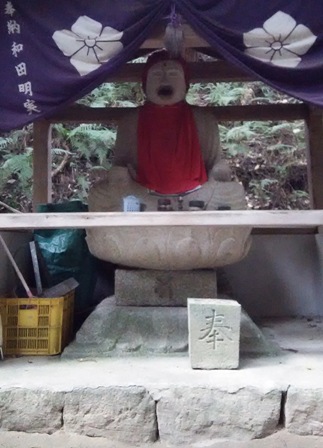
Hikisaki jizo in Taisan-ji temple
Jizō is a Bodhisattva (Jp. Bosatsu), one who achieves enlightenment but postpones Buddhahood until all can be saved.
Jizō’s traditional roles are to save us from the torments/demons of hell, to bring fertility, to protect children, and
to rant longevity -- thus Jizō is often decked in red.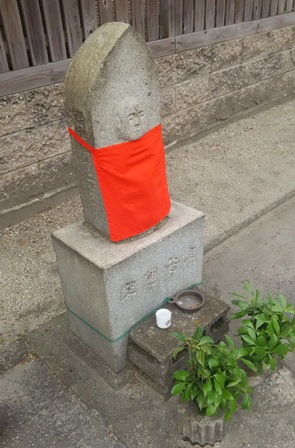
Parents cloth Jizō statues in hopes that Jizō will cloth the dead child in his protection.
The dead children are sent to Sai no Kawara, the riverbed of souls in purgatory, where they are
forced to remove their clothes and to pray for salvation by building small stone towers, piling pebble upon pebble, in the hopes of climbing out of limbo into Buddha’s paradise. Sorrowing parents pray Jizō to help the suffering soul of their deceased child.
This is why everywhere in Japan, at busy intersections, at roadsides, in graveyards, in temples, and along hiking trails, one will find statues of Jizō Bosatsu decked in clothing, wearing a red
or white cap and bib.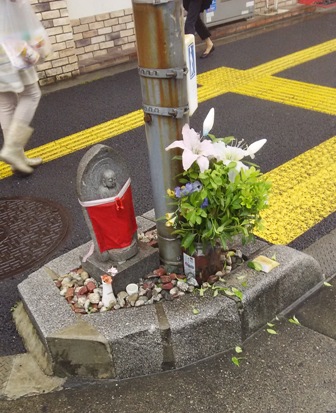
*




コメント 0